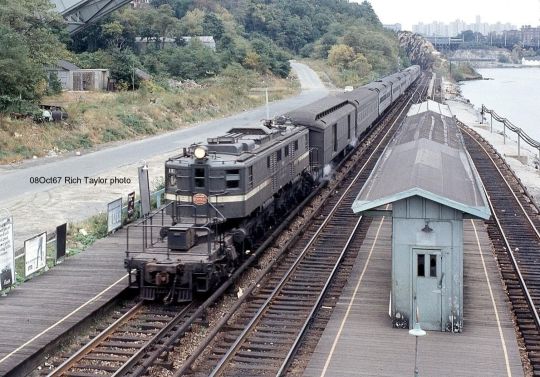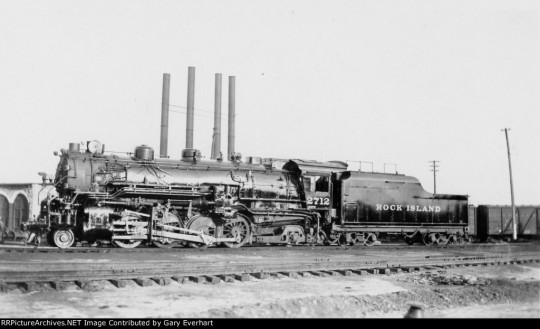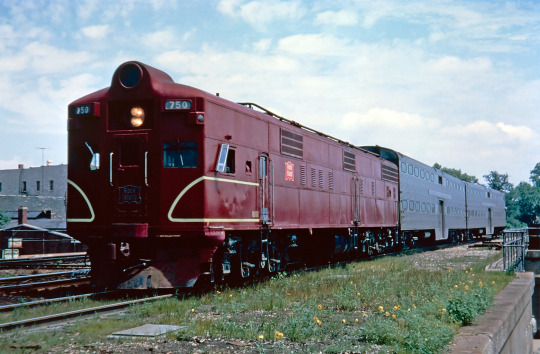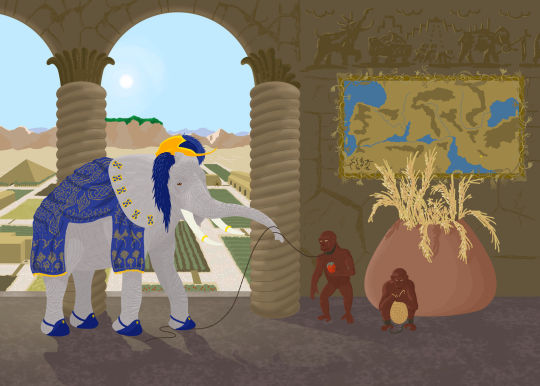#Rock Island locomotives
Text
Trainposting :3










#trainposting#amtrak#electric traction#reading railroad#amtrak cascades#southern railway#southern serves the south#northern pacific#rock Island Railroad#new york central#south shore railroad#union pacific#steam locomotive#passenger train#electrification#electric train
72 notes
·
View notes
Text
A week ago, I made a post showing my OCs from the Missouri Pacific. Now we’re finally reached the end of the line as this post will go over my OCs from the 20th and final railroad on this list, the…

And the Rock Island heritage fleet is under ownership of both Union Pacific and BNSF.

And the engines in this fleet are only found on railroad territories that were once occupied and operated by the Chicago, Rock Island and Pacific Railroad (CRIP or CRIPRR), or more commonly, the Rock Island Railroad. And these engines are…

Palmer, the 4-4-2 class A-24 #1041

Paige, the 4-6-2 class P-33 #905

Juliet, the 2-8-0 class C #2010

McCreedy, the 2-8-2 class K #2712

Renato, the 2-10-2 class N-78 #3011

Yuki, the 4-8-2 class M-50 #4049

Nadey, the 4-8-4 class R-67 #5020

Joyce, the 4-8-4 class R-67 #5114

Omar, the EMD AB6 #750

Angelo, the EMD AB6 #751

Culver, the EMD E8 #650

Geoffrey, the EMD E8 #645

Barrett, the EMD E8 #662

Kildow, the EMD SD40-2 #4790

Kari, the EMD SD40-2 #4793

Daphne, the EMD SD40-2 #4799
#rock island railroad#cri&p#steam locomotive#steam engine#diesel locomotive#diesel engine#train#trains#passenger train#passenger cars#freight train#freight cars#railway#railways#thomas and friends#thomas the tank engine#ttte#ttte oc#the genie team#locomotive#railroad#railroads#genie team
5 notes
·
View notes
Text
"It's a foggy misty morning at Chicago La Salle Street station with Rock Island Bicentennial unit to lead the way on a 20th Century fan trip to Bureau Jct IL."
May 13, 1976
Photo by Mark Llanuza
#railroads#railroad#trains#rails#rr#illinois#train#track#rail#tracks#Chicago#bicentennial#trainspotting#rock island#locomotive#diesel locomotive#emd#1976#1970s#independence day
39 notes
·
View notes
Video
youtube
Rock Island Tribute Metra Locomotive at LaSalle St. Station
#youtube#rock island#metra#locomotive#chicago#tribute#Rock Island Red#lasalle st. station#train#railroad#commuter#mass transit#transit#rta
2 notes
·
View notes
Text

Westbound at Joliet
One more early image, taken the same day as my previous post...
The train pictured may be the famed Super-C, a hot TOFC train that ran between Chicago and the west coast. It's westbound near the tower at Joliet once again. The Santa Fe ran parallel to the GM&O at this spot; the train will cross the Rock Island within seconds.
The lead locomotive is an SD45-2 built in May of 1974, so only a little over a year old. It has a 20-cylinder prime mover that produced 3600 horsepower.
One photograph by Richard Koenig; taken September 20th 1975.
#railroadhistory#railwayhistory#filmphotography#jolietillinois#jolietil#joliet#santaferailway#chicagorockisland&pacific#rockisland#gulfmobile&ohio#cri&p#santafe#atsf#gm&o
29 notes
·
View notes
Text

MKT 330, Council Bluffs, IA
Katy grain train power lays over at Union Pacific's Council Bluffs service track. When the MKT picked up Rock Island's OKT trackage they went on a used locomotive buying spree which included GP's from ICG, CR, and KCC. MKT330, a GP38AC, and the ex Kennecott Copper GP39-2 (one of 8) were part of that acquisition.
The MKT trackage rights to Council Bluffs were concessions granted to the Katy as part of the UP/MP/WP 1982 merger. With the purchase of the MKT by UP, the Council Bluffs-KC trackage rights were granted to the KCS, who operates over a circuitous BNSF route instead of the UP to reach Council Bluffs. Those rights now have rolled over to CP Rail.
3-1-87
#mkt#missouri kansas texas#icg#illinois central gulf#up#union pacific#1987#trains#freight train#history#council bluffs#iowa
21 notes
·
View notes
Text






I started with an Atlas N Scale GP 7 Undecorated locomotive. I added the tanks to the top of the locomotive. Then I painted it black, and applied a decal set for one of my favorite Rock Island paint schemes. To complete the model I added Micro-Trains pilot/couplers.
44 notes
·
View notes
Video
In The Cut por David Blazejewski
Por Flickr:
Some friends and railroaders gathered in the pouring rain for a little private photo charter on Rhode Island's own little railroad, the Seaview Transportation Company. The little Seaview Transportation Company doesn't have much in the way of scenery or geographic features along its 7 miles of 'mainline' across the Quonset Business Park on the east shore of Narragansett Bay. About the only spot of note is this deep cut through Devil's Foot Rock just west of the US Route 1 overpass at about MP 1.5 where the two legs of the railroad split to the waterfront in Quonset and Davisville respectively. The road's primary locomotive had been hand washed only a few days prior by the road's new VP (and me!) and hasn't looked this good in years. The rain really saturated the fall leaves and the vibrant blue making for a better scene than we expected. SVTX GP10 1855 was built as a GP9 in Aug. 1956 for the Baltimore and Ohio as their #6467. Later rebuilt by ICG's Paducah Shop she bounced around on different shortlines until coming to Rhode Island in 2006 where she was given this snappy paint job. To learn more about this railroad check out the longer caption with this shot: flic.kr/p/2nNXfxP North Kingstown, Rhode Island Saturday October 27, 2023
6 notes
·
View notes
Text
❝ love is a choice ❞ chapter i
summary: what was meant to be a simple, calm trip to an intergalactic museum ended up becoming a a trip through memories the doctor rather wanted to forget. only they weren't her memories. they were yours.
pairing: thirteenth doctor x reader (primary), eleventh doctor x reader
word count: 3.1k
warnings: a whole lot of angst, implied kidnapping, angry doctor

A museum! Not the most exciting trip when compared to the other places the Doctor has taken her companions, but ! But it was definitely needed after their last adventure. Two out of the three humans on said adventure nearly lost their hair to ultra powerful vacuums following a pretty nasty encounter with the locals. This misfortune was promptly apologized for. Several times.
Even so! The Harikane Intergalactic Museum of Rarities! Settled on the planet Earendel, it seemed like the perfect place to go for a lazy day. The Doctor had heard good things about it, but she didn’t feel the desire to ever check it out. She know she'd groan the entire time as she’d likely seen everything that the place had to offer, and probably knew more about it too! But she had promised the Fam something calming after… that. That promise had also definitely been an integral part of the numerous apologies she dealt out.
“Welcome, welcome!” A tall figure greeted the crowd of several dozen patrons at the museum’s entrance. Towering over most of the people present by several meters, the man in front of them had skin tinted a dark blue. Tusks sprouted from around his mouth, though the two that poked out were nothing in comparison to the horns that wrapped around his head. Dressed and groomed finely, it was evident that the man before them was high-profile. “I am the museum’s curator, Hacell, and I will be acting as your tour guide today. Welcome to the Harikane Intergalactic Museum of Rarities!”
The museumgoers clapped enthusiastically while the Doctor begrudgingly slapped her hands together. All it took was a nudge from Yaz to straighten up; a reminder that she promised this would be a quiet- extra emphasis on quiet- and peaceful endeavor.
“Behave,” Yaz snickered.
“Oi,” The Doctor playfully rebutted. “I’m supposed to be the one telling you lot that, you know.”
“We have many wonders for you all to see today! From the beautiful islands of Delta Cancri, and the battlefields of the Locomotion District of Van Maanen 2! We shall take a glimpse into the various corners of this universe we all call home! However ,” Hacell paused. He swept his gaze across the crowd for a dramatic effect. “What I think you’ll find yourselves most enthralled by is our most impressive installment: The Convention of Earth’s Humanity!”
Now, this piqued the Doctor’s interest. It wasn’t often Earth was included in museums like this. Really, a lot of alien species ignored it unless they were trying to invade it or watch it blow up. To have an entire exhibit dedicated to the little ball of rock and water was unheard of to the Doctor. Perhaps this trip wasn’t going to be as boring as she’d thought.
“And ,” Hacell spoke with another dramatic pause. “The most exciting of all! The centerpiece! The Muse!”
It had been just as everyone had expected: most of the museum was composed of relics from different places, but rather than being from across the globe like the three humans were used to, they were from across galaxies. And the Doctor? Well, the Doctor was really struggling to hold in all the comments she so desperately wanted to make. It was a visible struggle too.
And while all that was good and well, there was a clear desire for a specific exhibit while they were perusing. From the bits and pieces of conversation that could be picked up from the other patrons, it was apparent that nearly everyone wanted to see what this exhibit entailed. While the three humans apart of this group were no stranger to humanity and all it had to offer, curiosity filled their system. This “Muse” thing that he hyped up so much was niggling in the back of their minds.
“Ah! Here we are!” Hacell announced, throwing his arms out.
The other patrons gasped in awe of the series of human artifacts. There were some that were easily recognizable to the humans like an older iPhone model or some of those reusable Starbucks tumblers. Some weren't so familiar, like an object that looked like a regular headband, but had circuits and wires running throughout the fabric. At the very ends, there were what appeared to be headphones of some sort. Yaz seemed rather focused on it if the crease in her brow said anything.
“The Apple Neural Headphones,” The Doctor spoke over Yaz’s shoulder. It was clear she was still trying to reign herself in for the sake of her humans. “Makes it easier to go on all your socials without having to touch anything. They marketed it as a more hygienic alternative to phones, but it’s a total scam. Have to get the special contacts that go with it to even work it, can you believe?”
Before Yaz had the time to respond, a child’s voice sounded out from behind them. It drew their attention to whatever they had seemed eager about. “Look at this thing!”
Yaz gasped at the marvel in front of her. A crowd, including Ryan and Graham, planted itself in front of a pane of glass that took up the entity of the room’s back wall. Inside said glass was a moving display of a party, one that must’ve been from a time long before the 2020’s. The clothes the people were wearing, ironically, like they belonged in a museum. At the center of a room was a dance floor that was lit with red, blue, yellow, and green spotlights. Surrounding that was a series of tables, all lit dimly with small candles. In the far back, a jazz band was nestled in the corner, plucking and playing their instruments so that a vibey melody filled the empty space.
The closer one got to the glass, the more one could realize that it was so much more fascinating than looking at it from afar. The people were far too detailed, much too three-dimensional to have been mannequins moving on a track. The sheen of their skin, all the little imperfections, and the raw emotions that painted their faces showed what could only be described as, well, life-like!
“Wow…” Yaz gasped, her gaze settled on who was at the center of it all.
It was clear that they were the one whom the entire display was focused on. And if it wasn’t, it would be absolutely insulting. Amidst the cigarette smoke and twirling skirts on the bright dance floor, there was someone with a smile that combated the radiance from the spotlights. It took up the entirety of their face. It was unrestrained. An airy yet full laugh escaped their lips while they danced the Watusi, although she took the liberty of clutching the sides of their skirt to flap against her legs with every step they made on a pivot. It didn’t seem to be the right way to dance based on a couple judgmental glares received from some of the people around her. They didn’t seem to very well care.
“This must be the Muse the curator guy was talking about,” Ryan concluded.
“Wouldn’t be surprised,” Graham agreed.
Every so often, they would glance over their shoulder at a man with untimely long, dark hair who had tucked himself away at a table close to the dance floor with a couple gentlemen. He didn’t seem to be making conversation with them, choosing to keep his eyes trained on the grinning Muse. His intentful gaze never wavered. There was something in that look alone that told a long, detailed story about whoever these two were.
Yaz looked at the Doctor. She probably expected a long and detailed explanation about how they were able to create such a scene. What she was met with, though, was a decidedly unfamiliar version of her, one whose mouth was agape, eyes wide with an emotion that was near indecipherable.
“Doctor? You alright?”
The other two pairs of eyes turned to look at the Doctor, except she couldn’t make herself look at any of them. At anything. Well, anything other than who danced around the ballroom, eyes glistening with a type of glee that could only be defined as pure.
“Oh my stars…” She exhaled, like she was fighting back a more uncontrolled reaction. She placed her hand on the glass, right where the Muse was twirling about the dance floor. “Y/N… what have they done to you?”
The look of raw pain on the Doctor’s face caused Yaz’s own to scrunch up in concern. She didn’t recognize the name and she wouldn’t, at least not in relation to the Doctor. She was smart enough, though, to recognize that something was horribly wrong. “What’s-”
“A beauty, hmm?”
The Doctor remained motionless while Yaz, Graham, and Ryan swung their bodies to the source of the new voice. Hacell was standing beside them. He wasn’t looking at any of them in favor of keeping his line of sight solely on the Muse. On you.
“U-Uh,” Graham was the first to find the courage to answer. “Yes. W-What’s their name?”
“Name?” Hacell scoffed, as if it was a stupid question that was utterly beneath him. “They have no need for a name. They are simply The Muse. That’s all she needs to be.”
There was something sickening in the way Harcell spoke. He assumed that everyone around him thought you were just an object to gawk at. He probably would’ve been right, too, and probably had been countless other times before. Were it not for the distress on the Doctor’s countenance, the three humans would have smiled at the pretty moving display and moved onto the next.
Justified assumptions aside, the controlling dominance lacing his every word sent a jolt through the Doctor. Each individual nerve in her body lit up with a long buried intensity. She was shocked that her subconsciousness, which told her to keep still and silent, was winning over her consciousness, which was itching to go against one of the very principles she set as a foundation for herself: violence doesn’t help anything.
“How, um, how long has the Muse been a part of the exhibit?” Graham asked.
“Nearly eleven Earendelian years!” Hacell replied with pride. “Been through a lot of exhibits with us. This is just one of many scenes we like to show! We want to do more but- Well, this seems to be the one that attracts the most people… They are truly my most prized possession.”
Yaz was the one to notice it, out of the corner of her eye, the slightest movement. So slight, that if it weren’t such a new, unseen action, it wouldn’t go noticed at all: the Doctor’s fists clenched. And because those fists clenched, Yaz’s eyes trailed up to the Doctor’s face. That face… usually overflowing with energy and joy. And there it was, an ocean of unbridled rage covered by a cloudy blanket of false composure.
“Um,” Yaz fumbled with her words. She knew that she needed to get this man as far away from the Doctor as possible. In her line of sight, she saw a hoverboard encased in glass. It was the furthest artifact away from the display, so an idea formed in her head. She pulled Ryan in front of her. “Would you be so kind as to show my friend here that item over there? He wanted to know more about its history a bit earlier.”
“Wha-?”
Yaz gave Ryan an expression that was practically screaming at him to go along with it. She gave a tight nod of her head towards the Doctor in hopes that Ryan would notice and Hacell wouldn’t.
Thankfully, Ryan’s eyes flickered to the seething statue of a woman without the other catching on. He straightened his back and plastered
“Yes!” Ryan exclaimed through clenched teeth. “Please tell me. All about it.”
“Right then! In 2014, a man by the name of Shane Chen came up with the idea that humans needn't have to walk, but rather...”
Once the two of them were out of earshot, Yaz gripped the sleeve of the Doctor’s coat. She tugged on it so that the Doctor would get closer to Yaz so that she could hear what she was going to say, but the Doctor’s feet remained firmly rooted on the marble floors.
“Doctor-”
“A possession?” The Doctor spat. She remained still, but she didn’t need movement to convey the storm of emotion that was crashing against her insides. “A possession ? Y/N is not a possession. Y/N is-! Eleven years- And I- This is my-”
It almost felt wrong to be in this position. The Doctor wasn’t someone who broke down this easily; she was the one who was supposed to be calm, cool, collected or at the very least, her own disorderly version of that. To be so bare in front of the people she had promised she would keep safe wasn’t right. It wasn’t right that Yaz was leading her over to a bench, her hands on her shoulders in a calming motion. It wasn’t right that the cracks the Doctor had patched up were starting to show once again, the contents inside slipping through in the form of shaky hands and inability to form words.
“Okay, Doctor, listen,” Yaz said softly. “I need you to calm down. Breathe. If you get any louder, he’ll hear you over there and for some reason, I’m under the impression that that would be a very bad thing. Can you do that for me?”
The Doctor nodded silently, though her face said all the words that were needed. She wanted to say more, much more, but she was just as much aware as Yaz that allowing herself to speak at even a decibel higher could cause more issues. There were plenty of those as it were.
She took in a few deep breaths, effectively slowing her rapid heartbeats. She tugged at the roots of her hair to ground herself. If she focused on the slightly painful sensation, she could pull herself out of the sudden hurricane of emotion that surrounded her.
Maybe it wasn’t all that sudden.
This storm, this constant thrashing inside her body, it had been with her for years. Since her 11th face. It wasn’t the usual hum of chaos she felt, no. This one had a name, and it was yours. If she thought about it, and you were so hard not to think about, it would grow. So, she did what she always did when she felt the clouds begin to form: she ran. At one point, she even became a monk just to sequester herself away behind brick and mortar so that the storm couldn’t get in. Or maybe it was to keep the storm from hurting others, she never really knew.
For so long, it was a dull ache in the Doctor’s chest. It never fully went away, and a small piece of her didn’t want it to. She deluded herself for a time into thinking that it was a good thing. If she still felt the pain, she would always remember to look for you. Every adventure would double as a search for the companion she so stupidly lost. When, in reality, it was just her way of punishing herself over and over and over again.
The Doctor thought that if she found you, the storm would dissipate. Yet, there you were, and it was as if the storm had consumed her and ripped her apart to the point where even a regeneration wouldn’t save her.
You were trapped, as far as she could tell. Forced to live in this memory for eleven- the mocking irony was not lost on the Doctor- years! This memory that was supposed to be one of the most cherished you had, and it could soon become a nightmare once the Doctor figured out a way to get you out of there. A thousand possibilities of just how filled every centimeter of matter in her brain with the most prominent being her taking the antiquette hoverboard Yaz sent Ryan and Hacell to and smashing it against the glass.
“Who is this?” Yaz asked once she thought the Doctor was sufficiently stable. She didn’t have to look at you for the Doctor to know who she was talking about, but Yaz couldn’t help but examine you.
You were no longer dancing, simply opting to grab something from the bar at the back of the club. With a glass of clear colored liquid in your hand, you brought it up to your lips. Over the rim, you made playful eye contact with the man the Doctor no longer recognized as herself. She remembered that gleam of your eye. When your loss was still a fresh wound, that gleam would replay in her head like a DVD that scratched in just the right place.
“That’s Y/N,” The Doctor began slowly. If she spoke any quicker, her grip on her control would’ve loosened. “They… They were a companion of mine not too long ago.”
“What happened? I mean…” The crease in Yaz’s brow returned as she searched for the right words. “How did you two get separated?”
The Doctor studied her hands. Those hands. Two sets of hands ago, they were the ones that put you in this position, even if indirectly. “I lost them.”
“They passed away?” Graham asked.
“No, I lost them,” The Doctor corrected with a self-repulsed tone. “We had a… Something happened and they went through a rip in the time stream. Ended up somewhere in all of time and space. And I… I looked everywhere I could but- but all of time and space is a lot of ground to cover. So I just… I couldn’t find them. Until now, I suppose.”
The Doctor always made it clear that these excursions were dangerous. Taking her hand that she offered as she promised you journeys across the stars meant more than trips to the museum or drinking alien mojitos on a beach with blue sand and pink waters. There were always things at stake. They knew that, she made sure they did if Grace��s death hadn’t already. More often than not, the Doctor would stare those stakes in the face with that smile of hers that said “everything’s gonna be okay.” This was one of those rare moments they’d seen the weight of it on her shoulders.
“That must’ve been hard, Doctor,” Graham said empathetically. He knew the pain of having someone you love slip through your fingers, the Doctor knew that. But he didn’t know this pain and she doubted anyone did. “But you have to know that it wasn’t your fault. They fell. You couldn’t have known.”
The Doctor slowly stood to her feet. Shaking her head wistfully, she put a hand on the glass, thankful most of the other patrons had found other things to ogle at. She sighed, “Yeah… Except they didn’t fall. They jumped.”
#thirteenth doctor x reader#thirteenth doctor imagine#thirteenth doctor#eleventh doctor x reader#eleventh doctor imagine#eleventh doctor#doctor who x reader#13th doctor x reader#11th doctor x reader#doctor who imagine
229 notes
·
View notes
Photo

CRI&P FP7 #402 on the Peoria Rocket
Bureau, IL
July 5, 1958
#peoria rocket#cri&p#rock island railroad#1958#chicago#peoria#trains#passenger train#history#bureau#illinois
10 notes
·
View notes
Text
summer journals, 2023 🪡:
july 30: madrid
[…] These are the years of flux
july 17: marseille
if i write my diaries ever so neatly (calendaric-like) i would lose the gist, the cosmic stuff, the matter which remains mysterious and expressive and thus serves me well and true to write. i cannot raze the forest for the sake of order! yes there are many interesting things happening right now but they are even more interesting when i distort them into impossible shapes so they cascade into the realm of fiction
june 28: madrid
My locomotions betrayed me. In truth there was fickleness in every traveler, an inability to accept things as they are, a habit to run from ourselves. However genuine our amorousness (towards persons, places) a casualness persisted —too casual, I thought.
Whether these askew, detached relations with the world were right or wrong was irrelevant. It was not a matter of discussion among travelers. One either resisted or caved to them.
june 23: madrid
In the scorching heat (above 90 degrees) he said: “life is finally what one supposes it to be —eventful.”
It is the second night of summer.
june 10: porto
rebel against the I — if ever the first person singular an I beyond my self […]
june 1st: island of korčula
finally have time!
this summer i must work. write
write
write!
may 29: mostar
Bosnia. The sun bleaches the mountains, making the rocks curl. The Neretva dazzles, a river of turquoise opalescence. It swells the veins of this verdant countryside.
I see mosques, and gas stations, and strange, brutalist, Yugoslavian buildings from fifty years before. I see the carcasses of houses hollowed by the weeds. Most walls carry bullet holes.
It leaves a strange taste in the tongue how beautiful/indifferent nature can be in the face of human cruelty.
The bus is unbearably hot. As we approach Croatia, grey streaks the skies: rain will soon plummet. The air pressure drops. The humidity is vaporous. I can picture the mercury rising inside all the barometers.
may 5: extremadura, hours after leaving lisbon
Badajoz; a small town with an alcazaba and a Roman bridge over a river where rowers glide in the May light.
All small towns are alike, when one comes from the periphery: with the exception that one’s own retains the intensity of feeling —elation, desperation, etcetera. Whereas all others are impersonal, distant, insignificant, and to envision one’s life there is an exercise in futility. It escapes the imagination.
3 notes
·
View notes
Text
Spectember #5 Flying Eurypterid
Clatter-Drakes, Kikimor, Parachute Bugs (Jaekelopterus volares) are a curious breed of sea scorpion that can be found in rare clutches amongst the outer islands of Gennaios and the northern span of Fastodai.
Many scholars believe that the creatures come from somewhere within the vast Terracuzan Hurricane.
The second largest sea scorpion known to those of Arclund, Clatter Drakes on the surface vary little from their fully aquatic cousins at first glance.
Externally mind, the outside of their bodies being much flatter and their blue shells patterned to resemble the creating waves they soar above, and a third eye which rests on the bottom of their chin, allowing them to keep an eye above and below, ever watching for prey and predators, though many biologists are curious to learn what animal readily makes a meal of the twelve-foot long beasts.
Internally their bodies have a curious mixture of bladders that can fully with both water and air, giving the entities variable buoyancy as they choose, and can even expel it quickly to rocket free of the ocean or drop like stones onto the surf, often when in sight of prey.
Of course, one might be asking, how do they fly? Well, while their fore claws are well-muscled limbs used in both the capture of prey and primary locomotion on land, resembling a strange fusion of sea turtle and seal in movement, the rest of their limbs are fused together into a great membrane.
Clatter-drakes enjoy resting on the tops of sea spires and steep cliffs, where they lay their rock-colored eggs, as it is much easier for the great creature to launch from these areas.
They drag themselves off the cliff and unfurl their membranes, the undulations resembling the swimming fins of sea snails.
Their common names are derived from the clacking of their shells as they flap their wings.
A few folk have taken to eating their meat, claiming that it tastes like a heartier/sweeter crab, but lost ships have been known to look for Clatter-Drake pods, which often number around six in number, as the beasts only launch from the waves and into their air when they know they are close to land.
#spectember#speculative evolution#speculative biology#fantasy creature#fantasy world#arclund#Original Work#OC
2 notes
·
View notes
Text
Additional Locomotives for the 20 Railroad heritage fleets
One thing that I should mention is the idea that the heritage fleets of the New York Central, Pennsylvania Railroad, Chesapeake and Ohio, Baltimore and Ohio, Chicago and Northwestern, Milwaukee Road, Burlington Route, Seaboard Air Line, Illinois Central, Gulf Mobile & Ohio, Union Pacific, Northern Pacific, Great Northern, Southern Pacific, Atlantic Coast Line, Santa Fe, Norfolk and Western, Missouri Pacific, Rock Island and Southern Railway have the following diesels as helpers and additional engines, and these diesels would be repainted in the railroads’ paint schemes, and these diesels are…

EMD SD9’s

EMD SD60i’s

EMD SD80mac’s

EMD SD70mac‘s

EMD F40ph’s
NOTE: Please keep in mind that all this is optional and I’m unsure if I should make this official or not. But regardless, this idea is fun to think about.
#the genie team#new york central#pennsylvania railroad#union pacific#southern railway#southern pacific#northern pacific#great northern#milwaukee road#chicago & north western#norfolk and western#chesapeake & ohio#baltimore & ohio#seaboard airline#atlantic coast line#illinois central#rock island railroad#missouri pacific#amtrak#conrail
6 notes
·
View notes
Video
“The longest day of 1970, and shortly after I finished high school, a Rock Island westbound freight passes U.D. Tower and crosses the GM&O/ATSF diamonds behind two F7 (119-107).”
Joliet, Illinois
June 21,1970
Photo by Paul Enenbach
(via Joliet, Illinois, 21JUN'70 | The longest day of 1970, and sh… | Flickr)
#flickr#joliet#illinois#rock island#rock island line#CRI&P#railroad tower#RR#rail#rails#railroad#railroads#railway#railways#train#trains#trainspotting#track#tracks#locomotive#diesel locomotive#EMD#EMD F7#1970s#AT&SF#railroad junction#freight train#GM&O
39 notes
·
View notes
Photo

Gods of Salt, or the “““real””” origins of humankind
Might as well post it here directly. (original link, full text under the cut)
« Certainly Nature, when she left the making
Of animals like these, did well indeed,
By taking such executors from Mars;
And if of elephants and whales she doth not
Repent her, whosoever looketh subtly
More just and more discreet will hold her for it;
For where the argument of intellect
Is added unto evil will and power,
No rampart can the people make against it. »
– Inferno, Canto XXXI, 49-57
Consider the following facts:
#1: The Mediterranean Sea loses more water to evaporation than it receives from rivers: it only maintains its level thanks to influx from the Atlantic. Between 6.0 and 5.3 million years ago, in the late Miocene epoch, the closure of the Gibraltar Strait caused the Mediterranean to dry out. This is known as the Messinian Salinity Crisis, and it left vast deposits of gypsum and rock salt. At its apex, this event would have reduced the sea to a few puddles of hypersaline water, similar to today's Dead Sea, surrounded by scorching desert - with temperatures possibly reaching over 40°C due to high pressure. Its islands and peninsulas would have turned to massive mountain ranges up to 5 km tall ([1]). This event ended with the so-called Zanclean Flood, when the Atlantic waters rushed back into the basin, through not one but a series of waterfalls. The overall drop was more than a km, and the discharge of water has been estimated at a thousand time that of the Amazon River ([2]). That's enough to refill the whole Mediterranean in less than 20 years. A sumberged barrier, known as Camarinal Sill, forms the shallowest part of the strait, at only 280 meters below sea level ([3]).
#2: Nevertheless, despite its terrible conditions, the Mediterranean Basin still had enough hospitable land to allow animals to move from Africa to Europe, and vice versa. In fact, the climate, flora, and fauna of Africa and Europe were very similar in the Miocene. Dwarf species of hippopotami and elephants have been found in Cyprus, Crete, Malta, Sicily, Sardinia, the Balearics: all the main islands of the Mediterranean. The lowland-dwellers could have lived along rivers like Po, Rhone, and Nile, which would have cut much deeper valleys.
#3: The Miocene was also a time of great diversity of mammals. In particular, it was the golden age of elephants (which existed in every continent but Australia) and apes (which were even abundant in Europe). European apes included the swamp-dwelling Italian Oreopithecus, 9-7 million years old, which had a pelvis suited for an almost bipedal locomotion ([4]), and hands more capable of precision gripping than those of any living non-human ape ([5]). As for elephants, Primelephas, the likely common ancestor of mammoths and all living elephants, lived in Africa at the end of the Miocene.
#4: Molecular studies place the separation between the lineages of humans and chimpanzees between 7 and 5 million years ago, later than Oreopithecus, and corresponding with the Messinian event. Recent estimates push the divergence backward, even to 10-12 million years ago; however, controversial studies suggest that the two lineages exchanged genes as recently as 4 million years ago ([6]). Clearly the process of separation was more complex than we realized at first, and involved some degree of hybridization between the recent lineages.
#5: The Mediterranean region contains a vast diversity of halophytes, plants than can grow despite high concentrations of salt. Many of these are suitable for human consumption: the oil-rich salicornia (Salicornia sp., eaten both fresh and pickled), the cabbage-like sea kale (Crambe maritima, which grows spontaneously on sandy beaches), the spinach-like sea orach (Atriplex halimus, a close relative of which is grown in India as vegetable and livestock fodder). The argan tree (Argania spinosa) is extremely resistant to both salt and drought, and is prized in Europe and North Africa for its wood and oil. ([7])
#6: The list of Mediterranean halophyte species is actually much wider, but many plants that grow in these conditions are not useful to humans: for example, the Mediterranean beard-grass (Polypogon maritimus), a close relative of oat and wheat, much less nutritious than either. Note, however, that elephants (much more common and diverse in this region in the Miocene) have very low nutritional requirements, and can feed on almost any type of vegetable matter. Now, a key characteristic of the Miocene epoch is a wide spreading of grasslands, replacing the forests that earlier covered most of the globe, triggering a wave of adaptation and diversification among mammals. In fact, between 10 and 5 million years ago, the diet of elephants has switched from leaves to tall grass, a change that can be seen in the shape of their teeth ([8]). Only in the last million years elephants have reverted to eating leaves ([9]).
#7: Until recently, the divergence between humans and chimpanzees had been linked to this event: the ancestors of chimpanzees would have remained in the thick rainforests of West Africa, while humans evolved in the new savannas of the east. This places human evolution entirely in eastern and southern Africa until the last million years or so. This view has been challenged by recent finds. In 2002, the 7-6 million years-old Sahelanthropus tchadensis, a serious contender as common ancestor of humans and chimpanzees, was discovered in Chad, in North Africa. Its foramen magnum suggests an already bipedal pace, as with Oreopithecus ([10]). In 2017, curiously human-like teeth, 7.2 million years old, were attributed to Graecopithecus, in Greece ([11]). Finally, in the same year, 5.6 million years old footprints that clearly show bipedal locomotion were found in Crete ([12]). All of this suggests that the earliest human evolution occurred at first in the Mediterranean region.
#8: The intelligence of elephants is well known. Their brain, over 5 kg heavy, has more cortical gyres than any primate or cetacean, and they might rank in intelligence besides chimps and dolphins ([13]). They form matriarchal herds with extremely strong interindividual bonds and great capacity for cooperation and reciprocal help. They are the only known non-human animals that seem to have ritual behavior related to death ([14]). Pregnant elephants have been observed chewing on leaves of a Boraginacean tree, used to induce labor or miscarriage by Kenyan women ([15]). They can use branches as simple tools, cover water pools to prevent evaporation, and use logs to disable electric fences ([16]). They can recognize themselves in the mirror ([17]), and seem to have artistic inclinations ([18]). Such abilities are especially astonishing in view of such an energy-poor diet. Yet we have seen that their diet was very different in the latest Miocene - that there are plants that grow in the Mediterranean region, could be eaten by ancient elephants, increased in diversity at that time, and are closely related to our food crops.
#9: The elephants' trunk is a dexterous organ of manipulation, capable of handling single seeds and inspecting delicate bodyparts like eyes. Nevertheless, having only one grasping organ could be a handicap for an active tool user (the two fingerlike tips are unique to the African species, and probably didn't exist in Miocene elephants). The trunk can lift loads of hundreds of kilograms, but it's poor at grasping large objects, and can only wrap around them. In comparison, the hands of apes are much more versatile, especially after the innovation we have seen in Oreopithecus. In addition, the same amount of food that sustains an elephant with its single trunk can support not two, but several ape hands - especially since high-energy primate food can pack nourishment in a much smaller mass, even when inedible to elephants.
#10: African elephants in reserves readily initiate contact with humans, often forming long-lasting individual bonds, and often prefer to interact with humans than with other animals of their environment. Many of these elephants appear more relaxed and at ease near humans than near even other elephants. This effect has been documented in species with a long history of domestication by humans, such as dogs and horses. ([19]).
Let's place everything together. Six million years ago, near the end of the Miocene epoch, the natural closure of the Gibraltar Strait turned the Mediterranean Sea into a salty desert. The few inhabitable spaces provided a safe passage between Africa and Europe for many species; elephants and apes, which had been increasing in diversity for all the Miocene, were among them.
The depths of the new Mediterranean basin, on the other hand, were a hellish environment that must have forced many species into desperate adaptations. Many plants learned to grow in sand, long before the Sahara became a desert, with concentrations of salt that would kill most others. Elephants, we've seen, are good at finding and storing water, using tools to prevent evaporation from reserves. They must have evolved their characteristic intelligence to deal with the unique challenges of the Mediterranean Basin. Like the Khoisan hunter-gatherers of the Kalahari desert (or for that matter the earliest Homo sapiens) they needed advanced problem-solving skill, good memory, and the ability to cooperate and trust each other.
Their eventual solution to ensure themselves a food supply in the great basin was agriculture. Many Mediterranean halophytes are edible even in the seed- and fruit-focused human diet; but the sapient elephants of the Miocene could feed even on simple grass. Cereals like Polypogon - which are, after all, nothing more than especially nutritious grass - must have been a blessing. Perhaps they were even selected artificially to tolerate more saline soils, as could have been the precious argan tree.
Still, the burgeoning elephantine civilization was slowed down by their sluggish reproduction and by their limited capacity for manipulation. The trunk was very effective, but every elephant could only hold one thing at a time. They must have experimented with many forms of animal labor (as well as hydraulic, etc.), but none of the many animals of their region could help them handle objects, make cheap craftwork, or operate machines.
Eventually, they started working with apes. Maybe they took a sample of Oreopithecus descendants or Graecopithecus from the northern highlands. They were clever animals, forged by the same cruel environment, capable of understanding gestures and executing simple orders. They wouldn't take away the hard leaves and grass of their masters, but they would eat almost anything else (to the elephants, the ability to digest meat must have seemed extremely precious). They had hands: two hands to grasp a broad object without handles, to scatter seeds on a field, or to hold hammer and chisel in the making of a triumphal arch.
So the elephants found themselves ruling over a vast caste of small, nimble, infinitely versatile slaves. Surely they must have tried to enhance them through selective breeding, as humans did with dogs and horses, creating features similar to the short jaws and small teeth of humans, or the peaceful countenance of bonobos. Their genes still bear traces of closely related lineages being interbred. They certainly encouraged a bipedal gait, so that the precious hands remained always free. With ape-servants so common and useful, crawling all around like living robots, elephants must have had little incentive to improve their technology further.
Remember the air at the bottom of the Basin was very thick: it's likely the elephants were specially adapted to breathe it, and would feel much discomfort outside of their cradle. They never ventured beyond what today is the coastline of the Mediterranean, which must have looked like impassable mountains to them. However, they could have sent their servants in exploration on the great islands: leaving, for example, the mysterious footprints of Crete.
The proboscidean rulers probably didn't have much more concern for their primate slaves than humans have for cows in a slaughterhouse. Even though they couldn't eat them, they could still fashion their skins and bones into precious objects; sacrifice them to elephantine gods atop of a ziggurat raised by their work; make them fight in blood games or proxy battles; use them for carnal gratification or for medical experiments. The different proclivities of humans, bonobos, and chimpanzees can be understood as specialization for such tasks. We can only wonder what the apes could understand of their condition.
The civilization of elephants had 600,000 years to develop between the Messinian Crisis and the Zanclean Flood: thrice the age of our own species. Certainly they studied in depth their secluded world. As the sea level started to increase on the Gibraltar Strait, they would have probably predicted the danger, and built a massive dam to block the way of the Atlantic waters. Maintaining this dam must have been the highest priority. But there were certainly those who didn't believe this looming danger. And in the end the central sin of the elephantine empire must have caught up to them.
What could have distracted the elephants from preserving the Mediterranean Basin as they found it? Probably action from those who had nothing to lose from utter destruction - such as ape-slaves who had finally crossed the threshold of self-awareness. Or rather a preemptive action from those who feared a revolt more than their own annihilation? Some kind of sabotage action, perhaps, that ended a millennia-spanning history by breaking down the great dam, letting the ocean pour into the Basin with an unimaginable catastrophe, and turn it back into a sea.
Some survived, both apes and elephants. They must have been few, perhaps outcasts that had fled, or had been exiled, to the outer highlands. Gradually they accustomed themselves again to the thin air (maybe this didn't even require evolutionary adaptation, just individual assuefaction; but the lords below were used to comfort...). Some were stranded on the new islands, and became the dwarfs of Cyprus, Crete, Sicily. The others scattered into the wilderness of Africa and Europe.
Without the infrastructures of the submerged empire, unprepared for the different environment outside, they were unable to rebuilt their civilization. Most of them had been poorly inserted in society, and their intellective faculties weren't the highest, either as a cause or a consequence of their isolation. Alone, they reverted to wild animals, and became gentler than they ever had been when they were civilized beings. They still retain the vestigial skills of artists and doctors; they still mourn the death of their kin.
The surviving apes, now free, wandered back into the heart of Africa, passing through Chad. Some found shelter in the jungles of Congo and Nigeria, others in the savannas of Kenya and South Africa, that perhaps reminded them of the flat lands where they were bred into their new shape.
Five million years after that unimaginable disaster, silt has covered all the ruins on the Mediterranean seafloor, and the "domesticated apes" have left Africa in three waves of migration. Now they control the world, from coastlines to mountains, they remake its land into cities and farms, and they hold in their power the fate of the distant descendants of their ancient masters.
It remains to be seen whether they will choose to be merciful or vindictive. Aren't five million years enough to expiate any sin?
39 notes
·
View notes
Text


Joliet
This image shows a Rock Island outbound commuter train clacking over the ATSF/GM&O tracks at Joliet. This has always been a great spot for rail enthusiasts.
The wonderful station here is made from Indiana limestone, but I'm not certain about the make up of iconic tower on the other side. The locomotive is an EMD E8A built for the Union Pacific in 1953.
Two images by Richard Koenig; taken in 1976.
#railroadhistory#railwayhistory#filmphotography#jolietillinois#jolietil#joliet#atsf#gm&o#cri&p#commutertrain#chicago#chicagotrains#chicagorailroads#e-unit#emde-unit
30 notes
·
View notes
